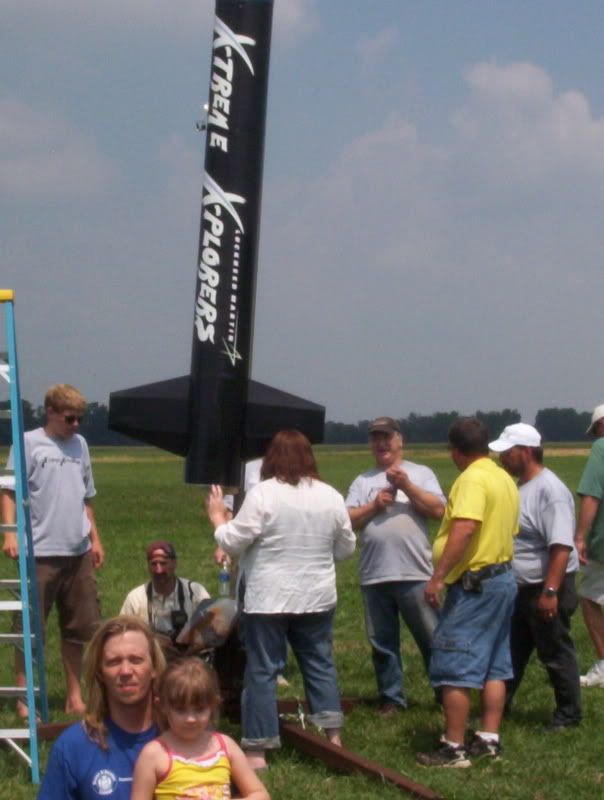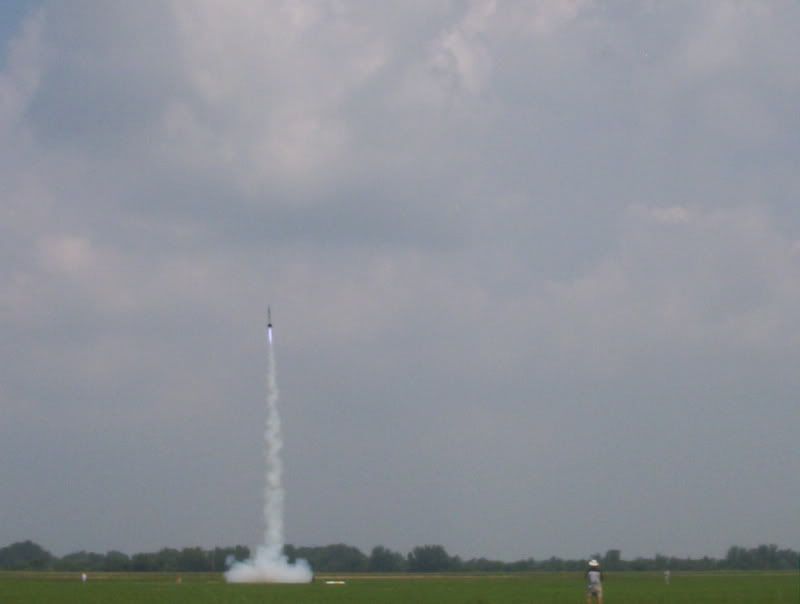Paralax products can whithstand at least 6.23 G's
I recently did a project for Lockheed Martin and The museum of Science and Technology where I built a sensor array. The array was was to yield data on the effects of G-Forces on robotics and a speedometer and a accelerometer. I used lost of different parts from lots of different manufacturers. This particular nike rocket pulled 6.23 G's and some robotics componets failed, but I am happy to say all the Parallax components passed with flying colors. The parallax parts inside the rocket were:
1 Paralax servo
1 Bs2 chip
1 Bs2 board
Here are some pics of me and my daughter at the launch.




▔▔▔▔▔▔▔▔▔▔▔▔▔▔▔▔▔▔▔▔▔▔▔▔
http://droidworks.org
Post Edited (walice_drel) : 9/28/2007 1:57:51 PM GMT
1 Paralax servo
1 Bs2 chip
1 Bs2 board
Here are some pics of me and my daughter at the launch.




▔▔▔▔▔▔▔▔▔▔▔▔▔▔▔▔▔▔▔▔▔▔▔▔
http://droidworks.org
Post Edited (walice_drel) : 9/28/2007 1:57:51 PM GMT


Comments
Then I googled "Nike Rocket". The first one was made in 1958. Hmm, learn something new every day.
Wiki states that is a solid-propellant rocket. How many pounds of propellant does it take to reach over 6G's?
▔▔▔▔▔▔▔▔▔▔▔▔▔▔▔▔▔▔▔▔▔▔▔▔
- - - PLJack - - -
Perfection in design is not achieved when there is nothing left to add.
It is achieved when there is nothing left to take away.
Very cool.
Bean.
▔▔▔▔▔▔▔▔▔▔▔▔▔▔▔▔▔▔▔▔▔▔▔▔
I know what I know, don't confuse me with the facts...
- - - - - - - - - - - - - - - - - - - - - - - - - - - - - - -
www.hittconsulting.com
·
Google for "High Power Rocketry"
These are not the "Estes" rockets, and there is a "qualifying process" that you have to work through in order to fly these things.·
▔▔▔▔▔▔▔▔▔▔▔▔▔▔▔▔▔▔▔▔▔▔▔▔
John R.
Click here to see my Nomad Build Log
Dave
▔▔▔▔▔▔▔▔▔▔▔▔▔▔▔▔▔▔▔▔▔▔▔▔
http://droidworks.org
I have always wanted to launch rockets... but first I have to find some spare time.... which is hard to come by
I read a lovely piece of urban legend last week. So, what was the first man-made object to reach outer space? Sputnik, one of the earlier, top secret military rockets, or a manhole cover.
I would have loved it to have been a manhole cover from one of the Nevada atomic tests.
Dr. Robert R. Brownlee comments on sending a manhole cover in space some time before Sputnik are:
… Incidentally, the Pascal B (atomic bomb) test, and those immediately following, had a 4-foot diameter pipe. The cap welded to the top of Pascal B was four inches thick, so was of appreciable mass from a "man-handling" point of view.
………………….
For Pascal B, my calculations were designed to calculate the time and specifics of the shock wave as it reached the cap. I used yields both expected and exaggerated in my calculations, but significant ones. When I described my results to Bill Ogle, the conversation went something like this.
me: "Thirty one milliseconds."
Ogle: "And what happens?"
me: "The shock reflects back down the hole, but the pressures and temperatures are such that the welded cap is bound to come off the hole."
Ogle: "How fast does it go?"
me: "My calculations are irrelevant on this point. They are only valid in speaking of the shock reflection."
Ogle: "How fast did it go?"
me: "Those numbers are meaningless. I have only a vacuum above the cap. No air, no gravity, no real material strengths in the iron cap. Effectively the cap is just loose, travelling through meaningless space."
Ogle: And how fast is it going?"
This last question was more of a shout. Bill liked to have a direct answer to each one of his questions.
me: "Six times the escape velocity from the earth."
·
Bill was quite delighted with the answer, for he had never before heard a velocity given in terms of the escape velocity from the earth! There was much laughter, and the legend was now born, for Bill loved to report to anybody who cared to listen about Brownlee's units of velocity. He says the cap would escape the earth. (But of course we did not believe that would ever happen.)
The next obvious decision was made. We'll put a high-speed movie camera looking at the cap, and see if we can measure the departure velocity.
In the event, the cap appeared above the hole in one frame only, so there was no direct velocity measurement. A lower limit could be calculated by considering the time between frames (and I don't remember what that was), but my summary of the situation was that when last seen, it was "going like a bat!!"
As usual, the facts never can catch up with the legend, so I am occasionally credited with launching a "man-hole cover" into space, and I am also vilified for being so stupid as not to understand masses and aerodynamics, etc, etc, and border on being a criminal for making such a claim.
=================================================================
“Houston to Manhole Cover – come in please!!!”
▔▔▔▔▔▔▔▔▔▔▔▔▔▔▔▔▔▔▔▔▔▔▔▔
"Star-ship Enterprise ships log 12 August 2030 - We're travelling the fourth Quadrant looking for Clingon. The bridge reports that a manhole cover has just passed us by on the port bow… Manhole cover… Confirm that Data, did you say a manhole cover???”
“Yes Captain, manhole cover - it's travelling like a bat!”
▔▔▔▔▔▔▔▔▔▔▔▔▔▔▔▔▔▔▔▔▔▔▔▔
Just last Saturday I flew a Sparkfun SD card datalogger on a rocket that pulled a max of 23.4Gs at launch. It held up to that just fine, but the charge used to blow out the main parachute also popped the SD card out of the push-push socket it was in (that also happened on the previous flight). I suspect the device suffered about 40-50Gs at ejection (that's a WAG, of course).
"It's an old SD card we found drifting in space Scotty, any chance we can read it?"
"Ochai Captain, just insert it in that multi-card reader on the bridge on Data's workstation."
Data takes the card, inserts it in a slot that looks suprizingly like a Sony multimedia player and rocket trajectory information scrolls across the black and white CRT screen
'So there may just be intellegent life down there on Earth after all..." Captain Picardi is heard to say under his breath.
Once an Enterprise fan, always an enterprise fan!!! (What the modern kids are missing)
▔▔▔▔▔▔▔▔▔▔▔▔▔▔▔▔▔▔▔▔▔▔▔▔
I see that Sparkfun has a new version of that datalogger out now, and it's smaller. I'm sorely tempted.
On my latest flight I maxed out at 23.4 Gs in the vertical direction, and at only 2.04 Gs laterally (when the opening parachute yanked on it), so obviously mounting it sideways would make a HUGE difference to survivability, as you suggested. That part isn't right, though. It'd be FAR better to mount the card so it also pops "sideways" (and given the design of the loggers, if the device is sideways, the card will be as well). There are two reasons:
1. The card slot is a push-push design: you push the card in to mount it, and you push on it again to get it to pop out. If I mount the card, and then put 23 Gs of force on it as the rocket launches, you can bet it's going to pop out. In fact, that's how the slot is designed.
2. The ejection charges also fire along the same axis as the motor, and the parachute pulls hard on that same axis when it opens. That means that there are strong forces in both directions on that axis during flight.
Post Edited (sylvie369) : 8/25/2008 10:20:54 PM GMT
Also, the device could log all data during the extreme phases of flight (until after the parachute deploys) to an EEPROM, then transfer the data to an SD card for viewing on a computer. This way you have easy access to the data via the SD card, but a reliable backup device with the EEPROM in case of SD failure.
Did you post any of your rocket in space photos?
humanoido
I've posted some of my pictures in the Flickr group "Rocket Aerial Photography" at http://www.flickr.com/groups/rap/·.· Is·there a website with·"rocket in space photos"?· None of my rockets have gone into space.· The highest they've gone is about 4,000 feet.
Dave Hein
Some of my pictures were taken by a $10 digital camera controlled by an SX.· My recent flights have used a FlyCamOne2 video camera strapped on to either a LOC IV or a LOC Forte' rocket.
Dave
▔▔▔▔▔▔▔▔▔▔▔▔▔▔▔▔▔▔▔▔▔▔▔▔
Chris Savage
Parallax Engineering